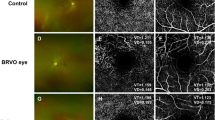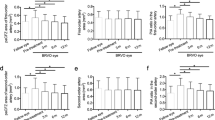Abstract
Purpose
To analyze vascular changes in branch retinal vein occlusion (BRVO) using projection-resolved optical coherence tomography angiography (PR-OCTA).
Methods
We reviewed 30 consecutive eyes of 30 cases with BRVO retrospectively. PR-OCTA was performed during the acute, intermediate, and remission phases when anti-vascular endothelial growth factor drugs suppress cystic changes. The main outcome measures were vessel density (VD) and retinal thickness changes in the superficial capillary plexus (SCP), intermediate capillary plexus (ICP), and deep capillary plexus (DCP).
Results
The VDs did not change longitudinally in the SCP and DCP during the follow-up period. The VD was significantly (p = 0.0105) greater in the ICP during remission than the acute phase. The full retinal thickness (internal limiting membrane [ILM] to retinal pigment epithelium [RPE]) and inner retinal thickness (ILM to inner plexiform layer [IPL]) decreased significantly (p = 0.0002 and p = 0.0014, respectively) during the follow-up period. When the inner retina was thinner than 117 μm, the VD in the ICP increased significantly (p = 0.045) during the follow-up period. When the inner retinal layer did not become thinner, the VD in the ICP remained unchanged.
Conclusion
PR-OCTA showed the three distinct vascular plexuses in BRVO. The VDs remained unchanged during the follow-up period in the SCP and DCP but increased significantly in the ICP during remission. Inner retinal thinning might cause increases in the VD in the ICP because of projection artifacts and segmentation errors despite using PR-OCTA.






Similar content being viewed by others
References
The Branch Vein Occlusion Study Group (1984) Argon laser photocoagulation for macular edema in branch vein occlusion. Am J Ophthalmol 98:271–282
Shilling JS, Jones CA (1984) Retinal branch vein occlusion: a study of argon laser photocoagulation in the treatment of macular oedema. Br J Ophthalmol 68:196–198
Rogers SL, McIntosh RL, Lim L et al (2010) Natural history of branch retinal vein occlusion: an evidence-based systematic review. Ophthalmology 117:1094–1095
Suzuki N, Hirano Y, Yoshida M et al (2016) Microvascular abnormalities on optical coherence tomography angiography in macular edema associated with branch retinal vein occlusion. Am J Ophthalmol 161:126–132
Coscas F, Glacet-Bernard A, Miere A et al (2016) Optical coherence tomography angiography in retinal vein occlusion: evaluation of superficial and deep capillary plexa. Am J Ophthalmol 161:160–162
Samara WA, Shahlaee A, Sridhar J et al (2016) Quantitative optical coherence tomography angiography features and visual function in eyes with branch retinal vein occlusion. Am J Ophthalmol 166:76–83
Tsuboi K, Ishida Y, Yuichiro I et al (2017) Gap in capillary perfusion on optical coherence tomography angiography associated with persistent macular edema in branch retinal vein occlusion. Invest Ophthalmol Vis Sci 58:2038–2043
Hasegawa T, Murakawa S, Maruko I et al (2018) Correlation between reduction in macular vessel density and frequency of intravitreal ranibizumab for macular oedema in eyes with branch retinal vein occlusion. Br J Ophthalmol bjophthalmol 2017 312769
Yeung L, Wu WC, Chuang LH et al (2018) Novel optical coherence tomography angiography biomarker in branch retinal vein occlusion macular edema. Retina. https://doi.org/10.1097/IAE.0000000000002264
Suzuki N, Hirano Y, Tomiyasu T et al (2016) Retinal hemodynamics seen on optical coherence tomography angiography before and after treatment of retinal vein occlusion. Invest Ophthalmol Vis Sci 57:5681–5687
Iida Y, Muraoka Y, Ooto S et al (2017) Morphologic and functional retinal vessel changes in branch retinal vein occlusion: an optical coherence tomography angiography study. Am J Ophthalmol 182:168–179
Winegarner A, Wakabayashi T, Fukushima Y et al (2018) Changes in retinal microvasculature and visual acuity after antivascular endothelial growth factor therapy in retinal vein occlusion. Invest Ophthalmol Vis Sci 59:2708–2709
Zhang M, Hwang TS, Campbell JP et al (2016) Projection-resolved optical coherence tomographic angiography. Biomed Opt Express 7:816–813
Hwang TS, Zhang M, Bhavsar K et al (2016) Visualization of 3 distinct retinal plexuses by projection-resolved optical coherence tomography angiography in diabetic retinopathy. JAMA Ophthalmol 134:1411–1419
Jia Y, Society O, Tan O et al (2012) Split-spectrum amplitude-decorrelation angiography with optical coherence tomography. Opt Express 20:4710–4725
Jia Y, Bailey S, Wilson D et al (2014) Quantitative optical coherence tomography angiography of choroidal neovascularization in age-related macular degeneration. Ophthalmology 121:1435–1444
de Carlo TE, Romano A, Waheed NK et al (2015) A review of optical coherence tomography angiography (OCTA). Int J Retina Vitreous 1:5
Spaide RF, Klancnik JM Jr, Cooney MJ (2015) Retinal vascular layers imaged by fluorescein angiography and optical coherence tomography angiography. JAMA Ophthalmol 133:45–46
Early Treatment Diabetic Retinopathy Study Research Group (1991) ETDRS report number 10: grading diabetic retinopathy from stereoscopic color fundus photographs—an extension of the modified Airlie House classification. Ophthalmology 98:786–806
Matlach J, Wagner M, Malzahn U et al (2014) Repeatability of peripapillary retinal nerve fiber layer and inner retinal thickness among two spectral domain optical coherence tomography devices. Invest Ophthalmol Vis Sci 55:6536–6546
Hasegawa T, Yamashita M, Maruko I et al (2017) Optical coherence tomographic predictor of retinal non-perfused areas in eyes with macular oedema associated with retinal vein occlusion. Br J Ophthalmol 101:569–573
Knudtson MD, Klein BEK, Klein R et al (2004) Variation associated with measurement of retinal vessel diameters at different points in the pulse cycle. Br J Ophthalmol 88:57–61
Funding
This study was funded in part by the Japan Society for the Promotion of Science (JSPS), Tokyo, Japan (Grant-in-Aid for Scientific Research, no. JP17K16993).
Author information
Authors and Affiliations
Corresponding author
Ethics declarations
Conflict of interest
Author KT has received a research grant from JSPS and Novartis Pharma KK and speaker honoraria from Abbott Medical Optics, Bayer AG, Novartis Pharma KK, and Santen Co. Author MK has received a speaker honoraria from Alcon Japan Ltd., Abbott Medical Optics, Bayer AG, Bausch & Lomb, Ellex, HOYA Surgical Optics, Johnson & Johnson, Kowa Co., Ltd., Nidek Co., Ltd., Novartis Pharma KK, Otsuka Pharmaceutical Co., Ltd., Pfizer Japan Inc., Santen Co., and Senju Co., Ltd., and received consultant fees from Astellas Pharma Inc., HOYA Surgical Optics, Nidek Co., Ltd., and Senju Co., Ltd.
Ethical approval
All procedures performed in studies involving human participants were in accordance with the ethical standards of the institutional and/or national research committee and with the 1964 Helsinki Declaration and its later amendments or comparable ethical standards.
Informed consent
Informed consent was obtained from all individual participants included in the study.
Additional information
Publisher’s note
Springer Nature remains neutral with regard to jurisdictional claims in published maps and institutional affiliations.
Rights and permissions
About this article
Cite this article
Tsuboi, K., Kamei, M. Longitudinal vasculature changes in branch retinal vein occlusion with projection-resolved optical coherence tomography angiography. Graefes Arch Clin Exp Ophthalmol 257, 1831–1840 (2019). https://doi.org/10.1007/s00417-019-04371-6
Received:
Revised:
Accepted:
Published:
Issue Date:
DOI: https://doi.org/10.1007/s00417-019-04371-6




